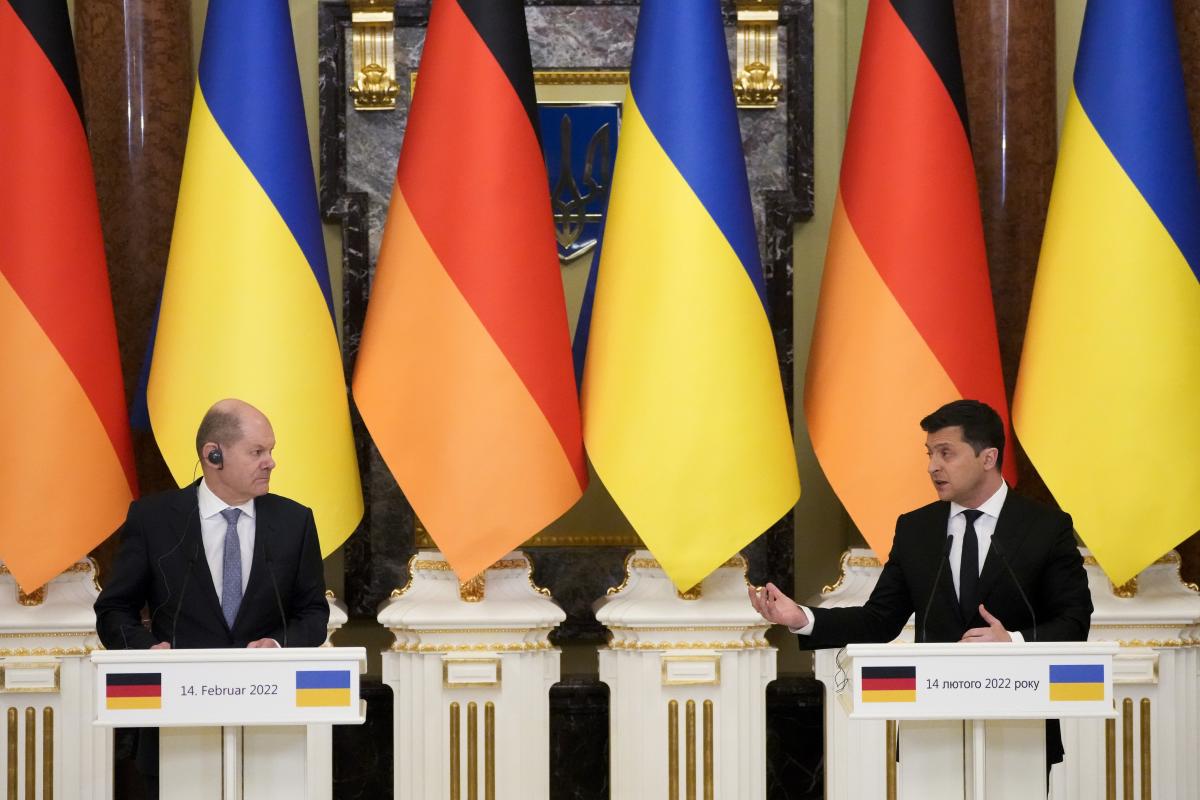
BERLIN (AP) — Diplomatic efforts to head off what U.S. officials have warned could be an imminent Russian attack on Ukraine entered a new round on Monday. Russia’s top diplomat advised President Vladimir Putin to continue talks and Germany’s chancellor met the Ukrainian president.
Britain’s prime minister said Europe is “on the edge of a precipice,” citing an American warning that Russia could invade Ukraine in the next 48 hours. But he said there’s still time for Putin to “step back.”
In an appearance orchestrated for TV cameras, Russia’s foreign minister argued that possibilities for talks haven’t been exhausted. That seemed designed to send a message that Putin himself believes hopes for a diplomatic solution haven’t yet faded.
Here’s a look at what is happening where and why:
WHAT’S THE MESSAGE FROM RUSSIA?
The Kremlin signaled Monday that it is ready to keep talking with the West about security grievances that led to the current crisis, offering hope that Russia might not invade Ukraine within days as Western officials increasingly fear.
Foreign Minister Sergey Lavrov said at a meeting with Putin that Moscow should hold more talks with the U.S. and its allies despite their refusal to consider the main Russian demands.
Lavrov said the talks “can’t go on indefinitely, but I would suggest to continue and expand them at this stage.” He noted that Washington has offered to discuss limits for missile deployments in Europe, restrictions on military drills and other confidence-building measures.
Asked by Putin if it made sense to continue diplomatic efforts, Lavrov responded that possibilities for talks “are far from being exhausted” and he proposed to continue the negotiations. He said his ministry wouldn’t allow the U.S. and its allies to stonewall Russia’s main requests.
WHAT’S GOING ON IN UKRAINE?
German Chancellor Olaf Scholz brought a message of solidarity to Kyiv, telling Ukrainian President Volodymyr Zelenskyy that Ukraine’s sovereignty and territorial integrity are not negotiable.
Scholz, whose visit came ahead of a meeting with Putin in Moscow on Tuesday, demanded “clear steps to de-escalate the current tensions” from Russia. He thanked the Ukrainian government for its “sober and restrained reaction to a very serious and threatening situation.”
Scholz noted that NATO and the U.S. have made proposals to Moscow that Germany supports, “and we now expect a reaction, an answer to them from Russia.” He urged Russia to accept offers of dialogue.
The German chancellor said in case of military escalation, “we are ready for very far-reaching and effective sanctions in consultation with our allies” and that “we know what to do” if Russia were to violate Ukraine’s territorial integrity again.
Once again, he didn’t spell out what exactly that would be. As expected, there was no shift in Germany’s refusal to join some allies in supplying Ukraine with lethal weapons.
Zelenskyy said the tensions around his country’s future present “an unprecedented challenge for Europe and the world.”
“It is in Ukraine that the future of the European security architecture — of which our state is a part — is being decided today.”
WHEN COULD RUSSIA MAKE ITS MOVE?
British Prime Minister Boris Johnson says Europe is “on the edge of a precipice,” citing an American warning that Russia could invade Ukraine in the next 48 hours.
“But there is still time for President Putin to step back,” Johnson said.
Johnson urged a united response from NATO. He said “the world needs to learn the lesson of 2014,” when not enough was done to move away from Russian gas and oil following Russia’s annexation of Crimea and activity in eastern Ukraine.
He said Europe needed to wean itself off “Russian hydrocarbons” and repeated his call for the Nord Stream 2 gas pipeline from Russia to Germany to be scrapped.
Johnson’s spokesman, Max Blain, declined to say whether the U.K. agreed with the U.S. that Wednesday is a potential invasion date. But he said “there is a grave possibility of an invasion this week.”
Separately, the head of non-NATO-member Sweden’s military forces said Russia has “all the needed capacity along the Ukrainian border for a military operation.”
“We do not exclude anything,” Gen. Micael Byden, the head of Sweden’s Armed Forces. “Whether it happens today, on Wednesday or a week, we do not know.”
AND WHAT IF TALKS DON’T SUCCEED?
Poland is making preparations to accept Ukrainian refugees in the event of another Russian attack on its neighbor. But the Polish government hopes that worst-case scenario can be averted.
Similar preparations are being made across the region, particularly in nations that border Ukraine.
Poland, which has welcomed large numbers of Ukrainian economic migrants in recent years, particularly after Russia’s incursions into Ukraine in 2014, has been making plans for weeks to accept refugees if it comes to that, said Marcin Przydacz, a deputy foreign minister.
HOW IS UKRAINE’S PRESIDENT FARING?
Zelenskyy won a landslide victory in 2019. As a political novice making an unlikely bid for the job, he had vowed to reach out to Russia-backed rebels in the east who were fighting Ukrainian forces and make strides toward resolving the conflict.
But Zelenskyy is watching his once-enormous support dissolve as Ukraine faces fears of a Russian invasion that could not only take the rebel regions but possibly the rest of the country.
To make matters worse, the incumbent whom Zelenskyy defeated in 2019 has boldly returned to the country to face charges of treason and stir up opposition to him. Analysts suggest that Moscow is seeking to bolster support among pro-Russia politicians in Ukraine and that the buildup of Russian forces near Ukraine’s border is aimed partly at destabilizing the country’s politics.
——
Yuras Karmanau in Kyiv, Ukraine, Vladimir Isachenkov in Moscow, Jill Lawless in London, Vanessa Gera in Warsaw, Poland, and Jan M. Olsen in Copenhagen, Denmark, contributed to this report.




